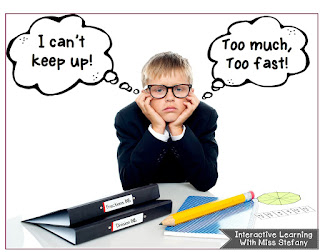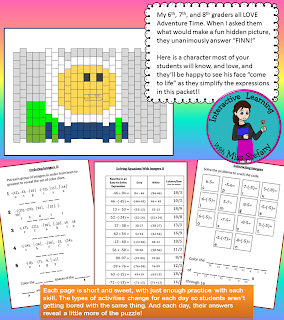My seventh graders ALWAYS struggle with the concept of adding and subtracting integers. There are only so many "real life" ways to express positive and negative numbers, and I know I've tried them all. Sometimes they help, other times the don't, and worst of all, sometimes they seem to help when they really don't at all.
This year, I have one student that was simply not getting it, no matter what. And she was stressed out about it (typically a math minded little girl). We spent several days, drawing pictures of thermometers and talking about the temperature (helps we live in Michigan, so she was very used to temperatures dropping below zero). We drew pictures of mountains next to the sea (I even have a
card game that uses this image, it's helped so many, but not her!).

I was at my wit's end when I decided to spend some alone time with my white-board and poster paper. I drew number line after number line, labeling and relabeling, organizing and reorganizing sets of facts. Until it appeared. Please tell me this is new to you, because in all of my years of teaching math and learning it through school, this pattern was NEVER pointed out to me, and I NEVER recognized it before.
In Kindergarten through third grade, we teach
fact families, er, number bonds. Why don't we use that concept in seventh grade with integer equations? When my little student saw this connection, she immediately understood what going on, and flew through homework, took her test and rocked it, and is now ready to deal with positive and negative decimals. (Let's hope that goes a little more smoothly!)
The numbers in this
fact family, er, number bond, are 2, 3, and 5, we must remember we are working with integers, so we also will be using the opposites of 2, 3, and 5 (-2, -3, and -5). We start with the number bond we are familiar with, 2+3=5, this is easy, we know how it works, we can apply the commutative property of addition to this equation, and just switch the place of the addends: thus 3+2=5. I wrote the out in different colors and marked them on the numberline in coordinating colors.
Now, we think about the rules we know about adding and subtracting integers. If we start with the 3, what can we add or subtract from 3 and end up at 5? My little smarty pants said, "subtracting a negative is the same as adding!" Fantastic! So 3-(-2) is virtually the same as 3+2, both result in 5 and both move on the numberline exactly the same. So we wrote that in another color and marked it on the numberline. You can see the blue and red following the same movement.
The next step was to apply the commutative property (in a sense) to this expression and see if it resulted in the same movements as out other number. That would be 2 -(-3), and sure enough, it does, It followed the same exact pattern as 2-3! ALL of these expressions are equal 5, AND work like addition on the numberline (moving spaces to the right of the starting number).
Next we moved on to adding negatives. My little student understood the concept of adding negatives and gaining negative distance from 0. She knew that to find the sum you add the absolute value and take its opposite. Easy as cake! Now what if you apply the commutative property of addition? YES! She found that -3+-2=-5 and -2+-3=-5.
Just like we did before, we stopped and asked ourselves, Is there any other way to start at -3 and end up at -5? YES! She immediately said, if you KCC! Gah! I can take a moment to express my loathing of this term? So she meant to keep the state of the first term, change the operation and the state of the second term. So, -3+-2 becomes -3-2. And yes, unfortunately, it works! I explained that is because adding a negative works the same as subtracting a positive, looks at our matching movements on the numberline ;)
Finally, we apply the commutative property (sort of) to -3-2 and we see that -2-3 ends at -5! My smarty pants students says, "Bah, BAM!"
Let me just take a moment and clarify that "sort of" application of the commutative property. We are really just expressing the same concept with different operations. We know that 3+2=5 and 2+3=5, that IS the result of applying the commutative property. However, when we are dealing with negative numbers, it doesn't always look so pretty. -2-3 is subtraction, and the property is only applicable to addition (and multiplication). However, when subtracting on the left side of zero, the numbers work together during subtraction as they normally do during addition on the right side.
We are to the related
fact family, er, number bond, are 2, 3, and 1, we must remember we are working with integers, so we also will be using the opposites of 2, 3, and 1 (-2, -3, and -1). This time we'll be focusing on subtraction. We started with the more difficult to visualize bond, so let's just pretend we started with the bond we are more familiar with, 3-2=1. We remember from our last exercise that subtraction is the same as adding a negative, so 3+(-2) should work the same as 3-2. Notice our color-coded movements on the numberline (green & blue on the top). Sure enough, it works!
Now let's apply the commutative property of addition to the last expression, 3+(-2) should equal (-2)+3, and it does! And our related expression, using our knowledge that subtracting a negative is the same as adding a positive (KCC, or Chum Chum). -2-(-3) is in fact 1!
But, what about that expression my dear student and I started with? 2-3. For those of us who have been working with these numbers for years, it's easy to see the result is -1, but what about our students who have been told for years you can't subtract a number from a value that is smaller? The number line really helps in this situation, As the student hops back 3 spaces from 2, they can clearly see the difference is -1. We also know that subtraction is the same as adding a negative, so we can re-write that equation to 2+(-3).
Applying the commutative property to that expression results in -3+2. We can reason without the number line that if I lost 3 pencils, and then found 2, I'm still missing 1, so yes, this expression equals -1. And then to find it's related expression, we must think, how else can get back to -1 when starting at -3? This is our KCC or chum chum "trick" (gah, I hate tricks!). -3+2 is the same as -3-(-2).
The actually math logic behind this trick is really much simpler than the trick itself. It's all about following the road signs. On our chart we wrote the negative (subtraction) sign with the arrow pointing left and the positive (addition) sign with the arrow pointing right. That is essentially the way the operation force numbers to move on the number line, regardless of the numbers value or sign. When the number that follows the operation is negative, it tells you to turn around (do a U-turn) and move the opposite direction. My son calls this illegal U-turns ;)
I hope some of these math meanderings will help you to help your students make sense of adding and subtracting integers. A while back I created a fun packet to help my 7th graders rewrite expressions into something easier to work with. In the end they create a colored page of a character most of them love.































